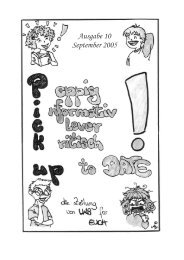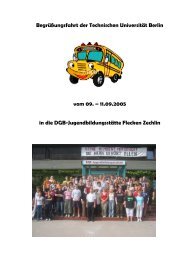Elegantes Telefax - JAV der TUB - TU Berlin
Elegantes Telefax - JAV der TUB - TU Berlin
Elegantes Telefax - JAV der TUB - TU Berlin
You also want an ePaper? Increase the reach of your titles
YUMPU automatically turns print PDFs into web optimized ePapers that Google loves.
1<br />
I. INTRODUCTION<br />
Integrated Water Resources Management (IWRM) has been developed nearly two<br />
decades ago as an encompassing new concept integrating the management of all<br />
water resources with the major water using sectors (water supply and sanitation, irrigated<br />
agriculture, environmental protection, flood protection, shipping and hydropower).<br />
Since then, it has been promoted as a concept for water policy reforms in<br />
most developing countries by a number of donor agencies and other international<br />
organizations dealing with water policy issues. The World Bank is clearly the most<br />
prominent donor institution endorsing the concept analytically and providing substantial<br />
financial support for its implementation. It prides itself for its intellectual lea<strong>der</strong>ship<br />
role and it un<strong>der</strong>took two major efforts – in the early nineties and between 2001 and<br />
2005 – in translating the concept into a set of policies guiding its own operations. The<br />
first round of reform was the result of the actions of external stakehol<strong>der</strong>s, mainly<br />
Washington based environmental Non-Governmental Organizations (NGOs), pressuring<br />
the US Congress and the US Treasury to request from the World Bank various<br />
procedural changes which amounted to an upgraded environmental review process<br />
and an IWRM based sector policy. The second effort ten years later originated from<br />
within the Bank and the sharehol<strong>der</strong>s emphasizing the implementation of IWRM principles,<br />
but reversing the retreat from dam-building that had occurred gradually over<br />
the 1990s. Here, the role of NGOs was minor and the stakehol<strong>der</strong>s included the major<br />
dam-building countries which make up a large share of the non-IDA borrowers.<br />
While not acting prominently in the process leading to and immediately following<br />
the United Nations Conference on Environment and Development (UNCED) in 1992 1<br />
which helped to propagate the concept among the UN participants and their constituencies,<br />
the World Bank started its own process at the same time preparing its 1993<br />
policy paper in Water Resources Management which contains most of the ideas of<br />
the IWRM concept, but has a Bank-specific emphasis on economic topics. A number<br />
of comparable processes in the water using sectors were pursued in the nineties,<br />
while creating analytical support internally with the water resources group and externally<br />
by engaging in supporting networks as the Global Water Partnership (GWP)<br />
and the World Water Council (WWC): The most prominent effort in dealing with a<br />
controversial topic was the participation in the creation of the World Commission of<br />
Dams (WCD). The internal review of the implementation of the 1993 policy paper by<br />
1 For account of the role of the IWRM during this phase cf. Scheumann and Klaphake 2001.





